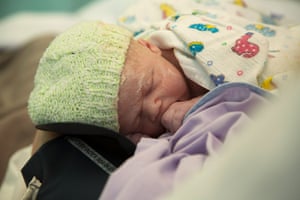
We’ve seen a lot of Australian hospital reality shows over the years. The standard bearer was Channel Nine’s RPA, which ran from 1995 to 2012 and followed a patient’s medical journey from the moment they entered Royal Prince Alfred hospital in Sydney. On air now is Kings Cross ER: St Vincent’s Hospital, also on Nine, a faster-paced medical show packed with drugs and stabbings, and Medical Emergency, on Channel Seven, which is set in Melbourne’s Alfred hospital’s trauma unit.
So why would the cash-strapped ABC mount an ambitious, seven-hour series filmed in a single day in multiple locations across Australia?
Executive producer Karen Dewey, who has an impeccable pedigree in medical observational documentary having worked on RPA, Medical Emergency and Making Babies, says the immediacy and scale is what makes Keeping Australia Alive a television project worthy of the ABC’s attention and not just another medical show.
“This is so different from RPA,” Dewey says. “In RPA you tuned into stories as the patients walked into the hospital and then followed them through until the end.
“Keeping Australia Alive has immediacy. We are there the first time Jane from Daylesford in Victoria is diagnosed with Alzheimer’s; the first time she hears what the doctor refers to as the scary word.
“We were there when Danny who has Parkinson’s disease undergoes the awake craniotomy and the tremors stop; when a nine-month old baby Ariana with a hole in her heart goes for surgery.
“I don’t think anyone could watch this and not find something that resonates.”
Keeping Australia Alive required even greater planning than most television programs because all the footage had to be captured in a 24-hour period. To achieve this near-impossible feat there was seven months of pre-production during which the country’s best producers scouted for good stories that could be told that day.
Each day in Australia 800 babies are born and more than 1,000 patients will be treated in a hospital trauma department where 27 will die. An estimated 1.2m Australians are looking after someone with dementia. How do you capture the human drama filmed everywhere from Ballarat to Perth and Bendigo, and translate it into seven one-hour episodes that still feel like they were made on the same day?

“It’s such a beautiful idea that you’re going to go into someone’s life for the most vulnerable 24 hours they may experience,” Dewey says. “We were there when Annie was just about to be wheeled down the corridor to have a double mastectomy, and her husband Gerry is saying goodbye. It’s a really lovely way to tell those stories.”
There could be no second takes or going back to find out what happened to the patients. The production used 100 cameras positioned from one end of the continent to the other, capturing metropolitan, rural, regional and remote health services in operation at the same time.
Series producer Elle Gibbons had the job of negotiating and securing access to 80 hospitals and clinics, dealing with health departments in each state and media liaisons in each hospital. And then there was the small matter of getting more than 1,000 consent forms filled out.
Dewey says some surgeries that were essential to catch, such as deep brain stimulation, were assigned two crews and two patients in case something went wrong on the day. Crews were positioned in 10 different emergency wards to get the stories that couldn’t be pre-planned and there were multiple crews stationed in maternity awards across two states.
“Some of the stories were ‘bankable’, in that the surgery was scheduled, some were speculative in that we were embedded in a neo-natal ward, for instance, where we couldn’t count on finding any stories until a day or two before shoot day,” Dewey says.
“The other difference is on RPA you couldn’t see people at home,” Dewey says. “We see Rita and Elbert who has had advanced dementia at home on Bribie Island and watch how she is coping with caring for him at home.”
The result was an overwhelming 550 hours of rushes that took four months to edit into seven coherent episodes, all starting in the morning and ending late in the day.
The sense of immediacy is heightened by the use of interstitials, which are inserted between scenes to show what is going on in the dozens of other locations from Wagga Wagga Base hospital to the Boigu Clinic in the Torres Strait.
“As we started watching the rushes I was saying there are so many great men in this series and it is so nice to see so many Australian men in such a nice light. In episode three there is Ron Ryan who looks after his mum Jane who has just been diagnosed with Alzheimer’s.
“And the little boy who has chopped the tip of his finger off when his mates were playing with an axe. He is just so Wagga Wagga. He calmly says, ‘can I go back to school tomorrow?’
“It was important that we captured the unique Australian system with its tyranny of distance, which is unlike anything else, and our system, which is half public, half private and manages to juggle the extraordinary contrast between remote and metropolitan patients.
“There is an incredible distance from north to south and east to west. We had a crew in the farthest northern part of Australia in the Torres Strait Islands where they still have tuberculosis.
“And that contrasted with incredible cutting edge heart surgery which takes place in St Vincent’s where they cool the patient down so they can bypass the heart. So you’ve gone from rudimentary medicine to advanced medicine all in the one country and all in the one system. All in the one day.”
• Keeping Australia Alive starts Tuesday 15 March at 8.30pm on ABC TV.